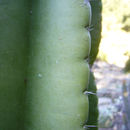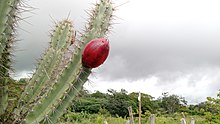en
names in breadcrumbs


Cereus jamacaru, known as mandacaru or cardeiro,[1] is a cactus native to central and eastern Brazil.[2] It often grows up to 6 metres (20 feet) high.
A thorn-less kind is used for animal feed. The most common kind is highly thorny but is also used for animal feed, after burning or cutting off the thorns. Mandacaru is highly drought-resistant.

The flowers are white and about 250 mm (10 in) long. The flower buds usually appear in the middle of spring and each flower lasts only for a night. They blossom at dusk and wither by the morning. Its fruit has a very strong violet color. The pulp is white with tiny black seeds, and it is considered very tasty. Many birds feed on them, like the "gralha-cancã" and the "periquito-da-caatinga" from Brazilian caatinga.
The mandacaru is featured on the flag of the city of Petrolina in the state of Pernambuco.
Cereus jamacaru, known as mandacaru or cardeiro, is a cactus native to central and eastern Brazil. It often grows up to 6 metres (20 feet) high.
A thorn-less kind is used for animal feed. The most common kind is highly thorny but is also used for animal feed, after burning or cutting off the thorns. Mandacaru is highly drought-resistant.
 The fruit of Cereus jamacaru
The fruit of Cereus jamacaru  The flag of Petrolina
The flag of Petrolina The flowers are white and about 250 mm (10 in) long. The flower buds usually appear in the middle of spring and each flower lasts only for a night. They blossom at dusk and wither by the morning. Its fruit has a very strong violet color. The pulp is white with tiny black seeds, and it is considered very tasty. Many birds feed on them, like the "gralha-cancã" and the "periquito-da-caatinga" from Brazilian caatinga.
The mandacaru is featured on the flag of the city of Petrolina in the state of Pernambuco.